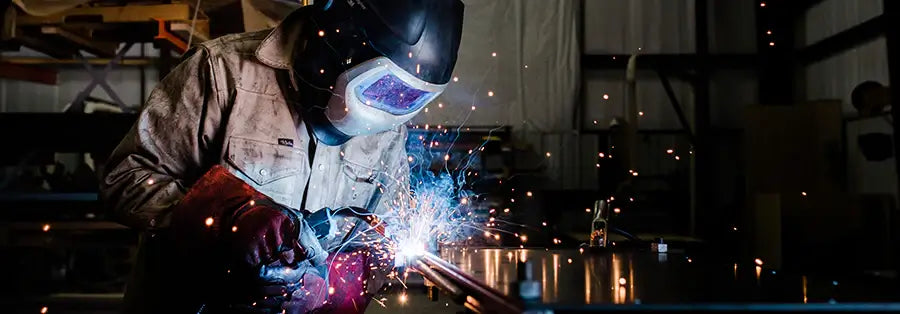As one of the best workhorses of the Millermatic line, the Millermatic 252 is more than capable of welding aluminum. However, to get good results, you definitely need to know the right way to approach your welds. In this article, we’ll take you through everything you need to know about MIG welding aluminum with the Millermatic 252.
A New World of Possibilities
Being able to weld aluminum is a game-changer. It’s lighter than steel with a good strength-to-weight ratio. This is one reason why aluminum is being used more often in products like vehicle parts and trailers. Aluminum is also essentially rust-proof and generally cheaper than steel (when compared by volume).
That all should sound amazing. However, aluminum is also a finicky beast for welding. One of its biggest issues is its higher coefficient of thermal expansion compared to steel. This essentially means that when exposed to heat, aluminum warps more than the Millennium Falcon. Beyond warping there can also be cracking and a variety of other issues if you don’t properly know how to tame this dragon. Here are some key tips to remember:
Consider a Spool Gun
A spool gun is highly recommended when MIG welding aluminum. The reason for this is because MIG welding aluminum requires a different wire than welding steel. The wire needed for aluminum is softer and easier to break. This creates a problem with most MIG machines (like the Millermatic 252) because they have drive rolls inside the machine to push the wire. The drive rolls of the Millermatic 252 have to propel the wire 15 feet through the MIG gun lining to the tip of the nozzle. That generally doesn’t present any issues with wire made of hard material, but soft wire can easily break inside the gun lining well before it even makes it to the tip of the nozzle.

A spool gun, such as the Spoolmatic or Spoolmate, gets rid of that entire problem by putting a small drive roll right on top of your gun. This way, the wire only has to be pushed a few inches, drastically reducing the chance of it breaking.
One awesome feature of the Millermatic 252 is that it automatically detects which gun you’re using and adjusts the settings accordingly. So if you have a MIG gun for welding steel and a spool gun for welding aluminum, you don’t have to worry about switching all the parameters every time you swap guns.

Welding Supplies from IOC sells a Millermatic 252 option specifically packaged for welding aluminum. This includes a compatible spool gun. For more details, check out it here.
Manage Your Heat
Compared to other processes like TIG, MIG welding generally produces more heat. This can make working with aluminum tricky as it easily warps compared to mild steel. The secret is learning how to manage your temperature.
First off, learning how to pre-heat your material is a must. It might not always be required for every aluminum weld, but pre-heating is a great way to minimize warpage and other related issues. To pre-heat your material, you can use an oxy acetylene torch, furnace or other options to heat the material to the required temperature (the exact degrees depends on many factors such as welding codes for your project, etc.).
Without pre-heating, there’s a drastic difference between the temperature of your material and the spots you weld. With pre-heating, the temperature differences aren’t nearly as severe. This allows for more uniform cooling, less warpage, cracking, etc.
It’s always a good idea, as well, to use clamps when welding thinner material. They’re perfect for restricting your piece to its current shape, helping prevent it from twisting or bowing. As one welding supervisor once said, “If there is a single clamp left in the shop not being used, you’re doing it wrong.”
Use the Right Settings
This last step is so simple, yet so often overlooked. With the Millermatic 252, there is an incredibly easy-to-use quick reference guide on the front of the machine. All you have to do is flip down the panel and navigate to the section on aluminum. By referencing your material thickness, it’ll give you the ideal voltage, wire speed settings and polarity. You can, of course, fine-tune these parameters, but the reference guide provides you with the perfect starting place.

It is important to note that while the Millermatic 252 has a simple and user-friendly control panel consisting of two knobs, it does offer control over more advanced settings in its timer menu. This allows you to adjust options like your pre-flow, post-flow, burnback and more.
In order to change parameters in the timer menu, start by holding down the MIG trigger while turning on the Millermatic 252. Keep the trigger held until the machine displays the word “RUN.” From there, you can turn the left knob to switch between different settings and the right knob to adjust them.
You should also make sure you have the right shielding gas connected to your Millermatic 252 for welding aluminum. The Millermatic 252 user manual recommends using 100% argon for welding aluminum. While this is usually the most common choice, if you are welding something to code, make sure to follow proper regulations.
With that, you should be all set up to start welding aluminum with the Millermatic 252. For more tips and tricks to MIG weld aluminum, check out our guide here.





